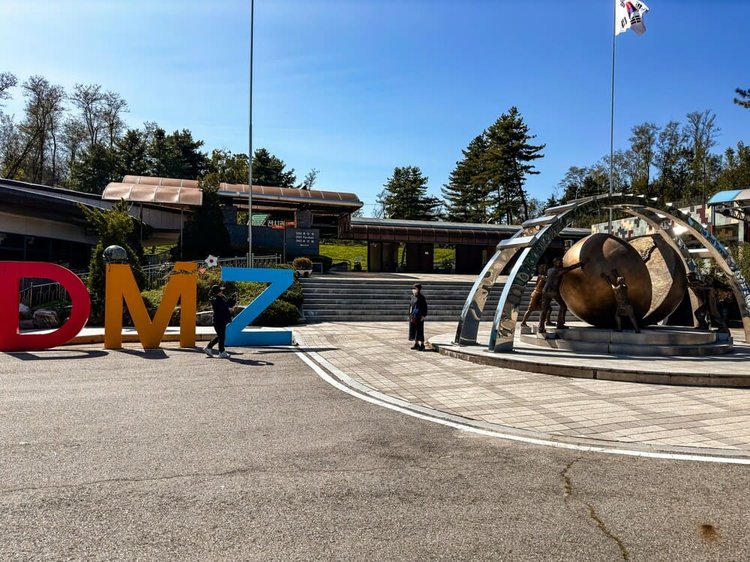Exploring Korea’s DMZ: A Unique Travel Experience
6 minute read

The Korean Demilitarized Zone (DMZ) is a compelling and historically significant tourist destinations. Established in 1953 under the Korean Armistice Agreement, this 250-kilometer-long and 4-kilometer-wide buffer zone separates North and South Korea, serving as a stark reminder of the Korea's division. Despite its military significance, the DMZ has evolved into a major tourist attraction.. This blog post provides a comprehensive guide to visiting the DMZ.
What is the DMZ?
The DMZ was created at the end of the Korean War (1950–1953) to act as a neutral zone between North and South Korea. Positioned roughly along the 38th parallel, the line that divided Korea into Soviet and U.S. occupation zones post-World War II, it is one of the most heavily fortified borders globally, featuring landmines, barbed wire, and armed guards. Spanning 250 kilometers from the west coast to the east, the DMZ is a no-man’s-land where military activity is restricted, yet it remains a hotspot for geopolitical tension. This historical significance makes it a fascinating destination for tourists.
Why Visit the DMZ?
Visiting the DMZ offers a profound and educational experience, allowing travelers to:
- Explore Korean History: Witness the tangible remnants of the Korean War and the ongoing division of the peninsula, understanding the human cost of conflict and the hope for reunification.
- Understand Geopolitical Tensions: Gain insights into the complex relationship between North and South Korea, symbolized by key sites like the Joint Security Area (JSA).
- Experience a Unique Destination: The DMZ combines history, politics, and nature, offering a perspective unlike any other travel experience, with views into North Korea and memorials reflecting Aspirations for peace.
- Reflect on Peace and Division: It serves as a living museum, prompting reflection on the past and present dynamics of the Korean Peninsula.

How to Visit the DMZ
There are two ways to visit the DMZ: through a guided tour or by visiting independently. Each option has its own advantages, and the choice depends on your preferences, budget, and time constraints.
Guided Tours
Guided tours are the most popular and straightforward way to visit the DMZ. These tours are organized by licensed operators and include transportation from Seoul, expert guides, and access to key attractions within the DMZ. Tours typically last from half a day (4–6 hours) to a full day (8–10 hours) and cover sites such as the Joint Security Area (JSA), the Third Infiltration Tunnel, Dora Observatory, and Imjingak Park.
Benefits of Guided Tours
- Convenience: Tours handle all logistics, including transportation, ticketing, and security clearances.
- Expert Guidance: Knowledgeable guides provide historical context and answer questions, enhancing your understanding of the sites.
- Access to Restricted Areas: Some areas, like the JSA, can only be visited with a guided tour due to security reasons.
- Safety: Tours ensure that visitors follow all rules and protocols, minimizing risks in this sensitive area.
How to Book a Guided Tour
Several reputable tour operators offer DMZ tours. When booking, consider the following:
- Tour Duration: Half-day tours are on average more budget-friendly and cover the main attractions, while full-day tours may include additional sites or more in-depth experiences.
- Inclusions: Ensure the tour includes transportation, guide services, and entry fees. Some tours may also offer lunch or hotel pick-up.
- Availability: DMZ tours operate daily except Mondays and certain holidays. JSA tours are typically available only on Tuesdays, Thursdays, and Saturdays, and require advance booking.
- Reviews: Check traveler reviews to ensure you choose a reliable operator.
Independent Visit
For those who prefer a more flexible and cost-effective option, visiting the DMZ independently is possible. This approach allows you to explore at your own pace and save money, but it requires more planning and effort. The primary destination for independent visitors is the Imjingak Tourist Center, where you can purchase tickets to access certain DMZ sites.
How to Visit Independently
- Get to Imjingak Tourist Center:
- By Train: Take the Gyeongui–Jungang Line from Seoul to Imjingak Station. Check schedules at Naver Maps or Korail.
- By Bus: Take bus 058A from Munsan Station to Majeong-ri, then walk approximately 40 minutes to Imjingak.
- By Shuttle Bus: Take a shuttle bus from various locations in Seoul to the DMZ.
- By Car: Drive to Imjingak; there is parking available.
- By Taxi: Take a taxi from Munsan to Imjingak.
- Purchase Tickets at Imjingak:
- Individual DMZ tickets cost 9,200 KRW per person and include access to the Third Infiltration Tunnel and Dora Observatory.
- Arrive early, especially on weekends, as tickets can sell out quickly. On weekdays, there may be more availability.
- Explore the Attractions:
- Use the free English audio guides available at Imjingak to learn about the sites.
- Note that there are no guided historical insights, so the experience is more self-paced.
Key Attractions in the DMZ
The following sites are commonly included in DMZ tours or accessible via independent visits, each offering a unique perspective on the zone’s history and significance:
Joint Security Area (JSA)
Located at Panmunjom, the JSA is where North and South Korean soldiers stand face-to-face. It’s the site of the 1953 armistice signing and a symbol of the peninsula’s division. Visitors may enter conference rooms straddling the border, technically stepping into North Korea. Note: Only accessible via guided tours.
Third Infiltration Tunnel
Discovered in 1978, this 1.5-km tunnel was built by North Korea for potential invasion. Visitors can walk through a portion, experiencing its cramped conditions.
Dora Observatory
A vantage point offering views into North Korea, including the propaganda village of Kijong-dong. Binoculars allow visitors to observe North Korean territory.
Imjingak Park
Just south of the DMZ, this park features memorials like the Bridge of Freedom, where prisoners of war were exchanged, and monuments reflecting hopes for reunification.
Current Status of JSA Tours
As of May 16, 2025, it seems likely that JSA tours are operational. However, availability can change due to political or military developments, and visitors should confirm with operators for the latest updates. For example, past incidents, such as a U.S. soldier crossing into North Korea in July 2023, have led to temporary suspensions, but tours have resumed.
JSA tours have strict requirements to ensure safety and security:
- Advance Booking: Reservations must be made at least 72 hours in advance, often longer due to limited daily visitor caps by the United Nations Command (UNC).
- Identification: A full-color passport copy is required for UNC registration, and the original passport must be brought on the tour day for verification.
- Dress Code: No sleeveless shirts, t-shirts without collars, short pants, skirts, sandals, or military-style clothing. Clothing with national flags or provocative designs is also prohibited to maintain neutrality.
- Age Restrictions: Minimum age is 12 years, with no exceptions, to ensure participants can follow strict protocols.
- Behavioral Guidelines: Visitors must adhere to strict rules, as the JSA is an active military zone, requiring respectful and compliant behavior.
Given the JSA’s popularity and limited capacity, early booking is essential, and travelers should be prepared for potential last-minute changes.
Practical Tips for Visitors
To ensure a smooth and enjoyable DMZ tour, consider the following practical tips:
- Prepare Documentation: Have your passport ready and submit required details well in advance, especially for JSA tours, to avoid delays.
- Follow Rules: Adhere to dress codes and behavioral guidelines to avoid tour cancellation or security issues, respecting the sensitive nature of the area.
- Check Weather: Some sites, like the Dora Observatory, are outdoors, so dress appropriately for the weather, especially during outdoor portions of the tour.
- Book Early: Popular tours, especially those including the JSA, sell out quickly, so plan and reserve as far in advance as possible. For independent visits, arrive early to secure tickets.
- Stay Informed: Monitor tour operator websites or news outlets for updates on JSA availability or tour restrictions, as political or military events can affect schedules.
- What to Bring:
- Passport: Required for all DMZ visits, especially if you plan to visit the JSA.
- Comfortable Clothing: Wear comfortable shoes for walking, and dress modestly, especially if visiting the JSA.
- Camera: While photography is allowed in most areas, be aware that there are restrictions in certain zones, particularly near military installations.
- Snacks and Water: Depending on your tour or travel plans, you might want to bring some snacks and water, as options within the DMZ may be limited.
The Korean DMZ is a destination unlike any other. From the iconic JSA to the eerie Third Infiltration Tunnel, a DMZ tour provides a profound perspective on Korea’s division and the hope for peace. Whether you choose to join a guided tour for a structured and informative experience or venture independently for a more flexible and budget-friendly option, a DMZ tour is a must-do experience in South Korea.
Related posts

Seagulls and tales await on Busan's Galmaetgil 9.1! From scenic villages to countryside hanwoo, join me on this 9km journey of bridges, blossoms, and an old friendly grandpa.

The ultimate guide to the Busan International Fireworks Festival! Learn about the best places to watch, ticket info, and tips for an unforgettable experience in Korea.



